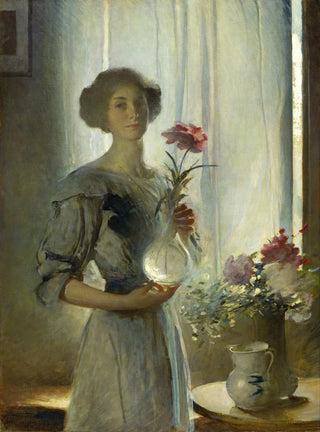Art print | June - John White Alexander


View from behind

Frame (optional)
Juin Art print - John White Alexander – Engaging Introduction
In the world of art, some works manage to capture the essence of a moment, a season, an emotion. "Juin" by John White Alexander is one of those creations that evokes the fleeting beauty of nature through a delicate and poetic representation. This piece, created at the end of the 19th century, is set within an artistic context where Impressionism and Symbolism intertwine, offering a new and refined vision of everyday life. The light, colors, and shapes blend harmoniously to create an atmosphere that is both serene and vibrant, inviting the viewer to immerse themselves in a universe where time seems to stand still.
Style and uniqueness of the work
John White Alexander's style is distinguished by his ability to combine realism and Impressionism, giving his works a rare emotional depth. In "Juin," the artist uses a palette of soft and luminous colors, evoking the warmth and gentleness of the summer season. The depicted female figures, often surrounded by flowers and greenery, are imbued with delicate grace, as if they are dancing in the light breeze. The use of light is particularly striking: it appears to filter through the foliage, creating plays of shadow and light that add an almost ethereal dimension to the composition. This work thus stands out for its ability to evoke sensations, to make one feel the warmth of the sun and the scent of flowers, while remaining rooted in a figurative representation.
The artist and his influence
John White Alexander, born in 1856, is an iconic figure of American art at the end of the 19th century and the early 20th century. Trained at the Pennsylvania Academy of the Fine Arts, he crafted a unique style that combines European influences with American sensibility. His work was widely recognized, and he played a significant role in the development of modern art in the United States. Through his portraits and landscapes, Alexander captured the spirit of his era, while fitting into a broader artistic tradition. His ability to portray the beauty of everyday life, through intimate and poetic scenes, has

Matte finish

View from behind

Frame (optional)
Juin Art print - John White Alexander – Engaging Introduction
In the world of art, some works manage to capture the essence of a moment, a season, an emotion. "Juin" by John White Alexander is one of those creations that evokes the fleeting beauty of nature through a delicate and poetic representation. This piece, created at the end of the 19th century, is set within an artistic context where Impressionism and Symbolism intertwine, offering a new and refined vision of everyday life. The light, colors, and shapes blend harmoniously to create an atmosphere that is both serene and vibrant, inviting the viewer to immerse themselves in a universe where time seems to stand still.
Style and uniqueness of the work
John White Alexander's style is distinguished by his ability to combine realism and Impressionism, giving his works a rare emotional depth. In "Juin," the artist uses a palette of soft and luminous colors, evoking the warmth and gentleness of the summer season. The depicted female figures, often surrounded by flowers and greenery, are imbued with delicate grace, as if they are dancing in the light breeze. The use of light is particularly striking: it appears to filter through the foliage, creating plays of shadow and light that add an almost ethereal dimension to the composition. This work thus stands out for its ability to evoke sensations, to make one feel the warmth of the sun and the scent of flowers, while remaining rooted in a figurative representation.
The artist and his influence
John White Alexander, born in 1856, is an iconic figure of American art at the end of the 19th century and the early 20th century. Trained at the Pennsylvania Academy of the Fine Arts, he crafted a unique style that combines European influences with American sensibility. His work was widely recognized, and he played a significant role in the development of modern art in the United States. Through his portraits and landscapes, Alexander captured the spirit of his era, while fitting into a broader artistic tradition. His ability to portray the beauty of everyday life, through intimate and poetic scenes, has






